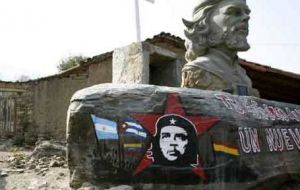MercoPress. South Atlantic News Agency
“Che” Guevara remembered 40 years after death
 Memorial at the place where “Che” Guevara was executed
Memorial at the place where “Che” Guevara was executed It's been 40 years since the militant revolutionary was executed in a Bolivian schoolhouse. To leftist governments across Latin America, he's still a beloved icon. It was a long fight, but the Cubans have finally conquered this forlorn Andean hamlet, four decades after Ernesto “Che” Guevara was executed in the adobe schoolhouse.
Cuban physicians provide healthcare, Cuban educators oversee literacy classes, and the Cuban-donated library features Che-as-superhero comic books. A monumental bust of the beret-topped revolutionary who helped Fidel Castro seize power in Cuba dominates the central plaza. "Great men like Che never die," said Ubanis Ramirez, one of hundreds of Cuban doctors and teachers imported by leftist Bolivian President Evo Morales, whose office features a likeness of Guevara crafted from coca leaves. "His lesson is with us always." Sympathizers from across the globe will make the trek to this remote corner of Bolivia this week to mark the 40th anniversary of the capture and killing of Guevara, militant leftist icon and global brand, the radical chic face adorning countless T-shirts, posters, album covers and tattoos. Today, the ideological legacy of this peripatetic militant may loom larger than ever in Latin America, abetted by the election of a "Pink Tide" of leftist governments from Nicaragua to Argentina. Socialism is in, the Cubans are on the march, and Che is the defiant embodiment of it all. To his critics, Guevara was a trigger-happy megalomaniac whose bloody example led thousands to their deaths in futile uprisings that only hardened military repression from Guatemala to Chile. But to the legions of devotees who subscribe to his personality cult, Guevara is forever the doomed idealist, the poetry- loving guerrilleroand "most complete human being of our age," in the words of Jean-Paul Sartre. "Our side is moving forward, and we don't have to go to the mountains and fight like Che did anymore," said Osvaldo Peredo, who heads Bolivia's Che Guevara Foundation and lost two brothers in guerrilla wars, one fighting alongside Che. Cuban doctors and petro- dollars from Hugo Chavez's Venezuela are the new arsenal in a nonviolent insurrection that Guevara, committed to armed struggle, could never have envisioned. "Finally, Che's dream is coming true," said former Mexican Foreign Minister Jorge Casteñeda, a Guevara biographer who casts Che more as wayward fanatic than inspired visionary. "Cuba's export of revolution is finally succeeding in many countries in Latin America, thanks to Chavez and his oil." A legendary guerrilla leader in the Cuban Revolution that ousted dictator Fulgencio Batista in 1959, Guevara stumbled in his 1960s struggles. Virtually exiled from Cuba after differing with Castro and Cuba's Soviet patrons, he suffered an ignominious defeat alongside anti-U.S. rebels in Congo before meeting his demise in a secluded Bolivian canyon at the end of a quixotic 11-month campaign. But, 40 years later, Guevara has scored big in the contested battleground of memory, emerging as a kind of secular saint, freeze-framed at age 39 between the Summer of Love and the abyss of 1968. Hollywood sees box-office cachet in Che: Director Steven Soderbergh is filming a new biopic starring Che look-alike Benicio Del Toro. "Today Che is associated in the collective conscience with values -- his ethics, his principles, his willingness to lose his life for an ideal," biographer Pacho O'Donnell wrote recently in the Argentine weekly Veintitres. Guevara, a physician with no formal military training, was also something else, critics say: prolific executioner, dogmatic totalitarian and co-designer of the Cuban police state and indoctrination apparatus. His detractors contend that his short life may appear to his admirers more James Dean than Chairman Mao, but his politics were more Comrade Stalin than Mahatma Gandhi. "What's left is a kind of idealistic, romantic aura," said Jorge Lanata, an Argentine journalist who has written about Guevara. "It's more culture than political." Guevara, keen to ignite "many Vietnams," chose impoverished Bolivia in part because of its proximity to his Argentine homeland, where he hoped to jump-start an insurgency. Today's Cuban volunteers in Bolivia live by the credo "Seremos como El Che! "All my life we communist pioneers pledged to be like Che," said Jose Valledaris, 45, a Cuban engineer who was watering shrubbery inside the Guevara mausoleum at a former military airstrip in nearby Vallegrande, where the bodies of Guevara and six fellow combatants were dumped in a ditch 40 years ago and buried. "Now I'm here, in the footsteps of Che." A renovated laundry shack behind the nearby Señor de Malta Hospital has become one of the most venerated stops on the "Che tour." It was here that the triumphant Bolivian military displayed Guevara's body as a war trophy atop a concrete washtub, and Freddy Alborta photographed the Christ-like figure of the pale, posthumous Che, his eyes wide open -- an iconic image distributed worldwide. Che pilgrims scrawl memorial graffiti on every available cranny. "Man is nothing more than his ideas," someone wrote in French. (MP/Agencies)




Top Comments
Disclaimer & comment rulesCommenting for this story is now closed.
If you have a Facebook account, become a fan and comment on our Facebook Page!